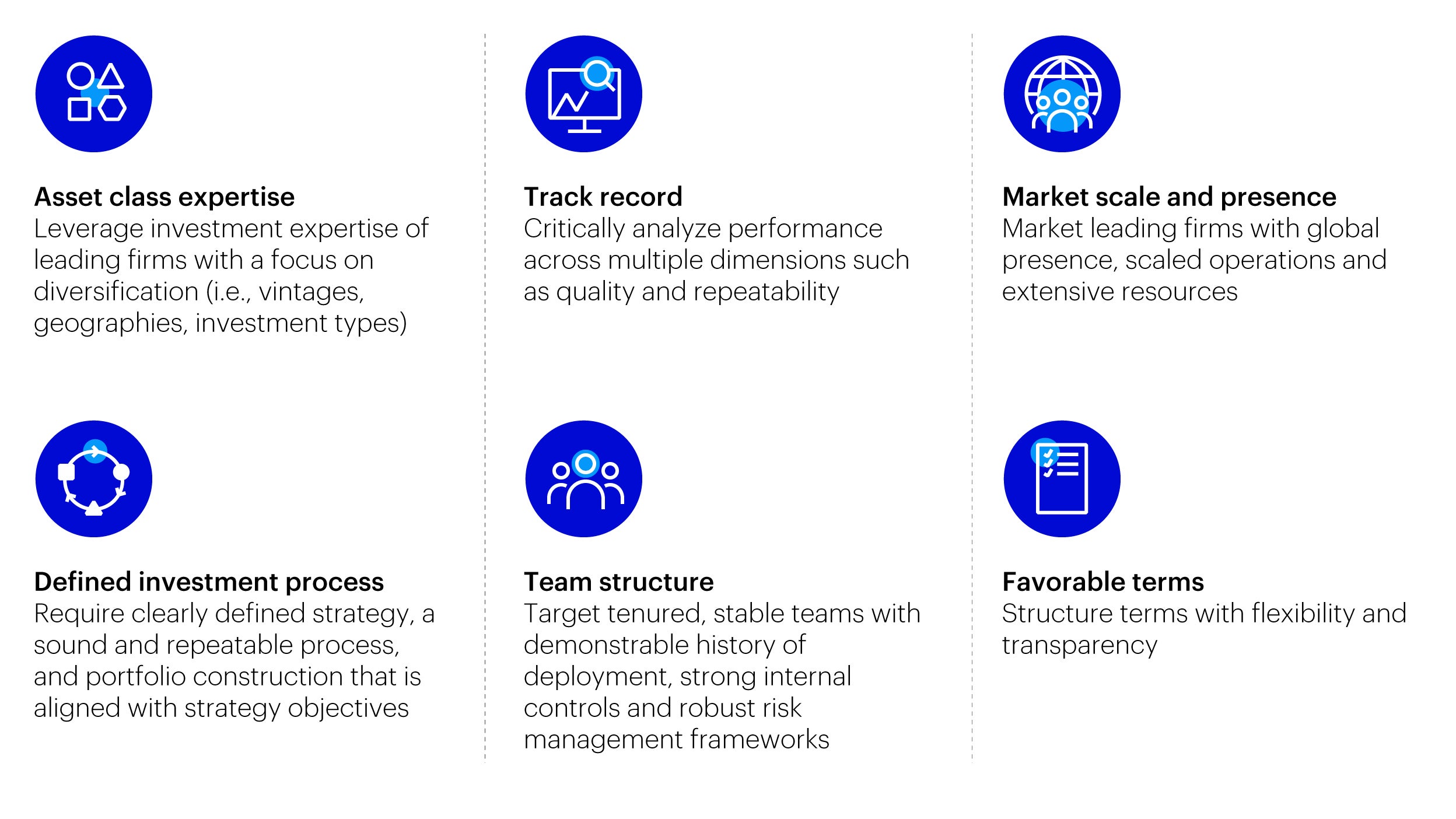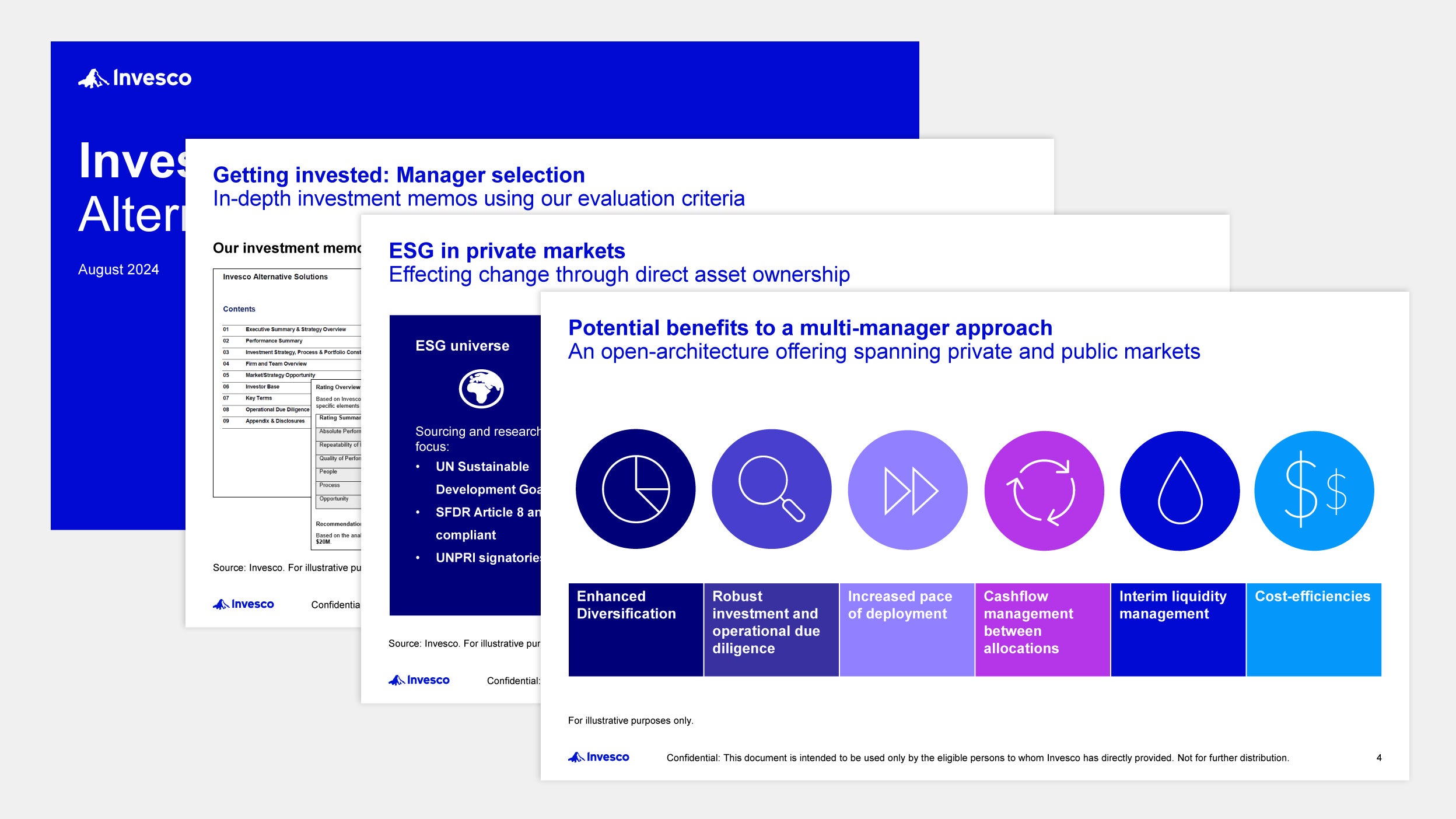Insurance Insights Q2 2025: Benefits of a diversified multi-alternatives strategy

In our discussions with insurers we often discuss the approaches used to review and assess asset allocations and emphasize the need to do this on a regular basis. The frequency of this exercise depends on the changing market environment (especially around long-term assumptions), and the constantly evolving nature of the liabilities or products. The need for any asset allocation to deliver on its expectations is a key factor, taking into consideration other constraints and metrics that insurers invariably need to operate under (i.e., asset liability management (ALM), capital or solvency implications, accounting impacts, and various other risk parameters, to highlight a few).
As we have indicated in our Q1 case study, a key input into this process is the capital market assumptions (CMAs). At Invesco, we generate a wide set of such assumptions which are updated on a quarterly basis and incorporate the latest market developments. For insurance-focused portfolios, other than just expected return or yield considerations, other aspects such as capital considerations of asset classes and the overall asset-liability matching profile need to be considered. We usually illustrate this through the charts below.
Figure 1 below assesses the attractiveness of asset classes in terms of current conditions and Figure 2 below re-assesses this based on the capital efficiency (expected return-to-standalone generic capital charge). We feel that combining these two elements can help narrow down the initial list of asset types to consider. While looking at one dimension alone could potentially lead to inefficiencies in the portfolio.

Source: Invesco as of 31 March 2025; Return on Capital = Expected Return / (Solvency Ratio * SCR). For fixed income assets, Barra's duration weighted yield to maturity is used as expected return. For other assets, Invesco CMAs are used where available. CMAs are as of 2025-03-31. Otherwise, manual inputs from Invesco Solutions are used. All the hedging of fixed income assets is based upon swap curves from Barra and basis curves from Bloomberg; where hedging is not assumed, yields / returns are converted into the report’s base currency based upon Bloomberg Generic Govt 10Y Yield differentials. Interest rate risk is excluded from SCR charges. Assets with zero SCR charges are not shown in the graph.
As an example, US taxable municipal bonds, US corporate A-rated and above bonds and shorter-maturity US corporate bonds have middle-of-the-road yields compared to some of the other asset classes. Yet if we were to consider these from a return on capital perspective, these asset classes appear relatively efficient. Of course, these charts will change depending on market conditions. Nevertheless, it remains important to assess portfolios across several dimensions and to ensure the objectives are valid and achievable.
[Please note that for purposes of this illustration, we have used the Solvency II Solvency Capital Required (SCR) standard formula for relevant risk charges as a proxy for risk-based capital (RBC) regimes.]
Updating the asset allocation: Incorporating new asset classes
We have shown earlier how the introduction of some representative alternative asset classes can help improve the efficiency of insurance portfolios.
To recap, our last issue showed the benefit of introducing select alternatives strategies such as value-add real estate, private equity leveraged buyout, and private credit. Avid readers would also recall that we use our powerful in-house portfolio management decision support system – called Invesco Vision1 –to compare different asset allocations. The charts below illustrate the impact of the addition of such asset classes – as complements to existing asset class exposures:


Source: Invesco analysis, 31 December 2024. For illustrative purposes only. There is no guarantee the expected return can be achieved. Indices/proxies used - Bloomberg Barclays US Long Treasury Total Return Index (LUTLTRUU IDX), US Corporate Total Return Value Unhedged USD Index (LUCRTRUU IDX), ICE BofA Asian Dollar Investment Grade Index (ADIG IDX), EM USD Aggregate USD Unhedged Index (EMUSTRUU IDX), Global High Yield Total Return Index (LG30TRUU IDX). MSCI World Gross TR Local Index (GDDLWI IDX), MSCI EM Gross TR Local Index (GDLEEGF IDX), FTSE EPRA Nareit Developed Index TR (RNGL IDX). Proxy – Invesco Real Estate US Value Add Index (IVZ_RE_US_VA), Proxy - Invesco Private Credit US Senior Corporate Unlevered Index (IVZ_PC_US_SRCORP0L), Proxy - Invesco Private Equity US Large Leveraged Buyout Index (IVZ_PE_US_LBO).
Figure 3 (left) shows the portfolio characteristics on an economic basis and Figure 4 (right) shows the characteristics on a generic RBC (risk-based capital) basis (estimated spread charge/equity charge/property charge for relevant asset classes). The blue line represents the frontier without alternative asset classes and the green line represents the frontier including allocations to alternative asset classes; the green and blue single points highlighted represent the respective portfolios.
We saw that there was an improvement in the return profile of the enhanced portfolio, and even with a slight increase in the estimated RBC charges, the adjusted portfolio still looked fairly efficient.
Going beyond: Impact of adding diversified multi-alternatives exposure to a portfolio
Careful diversification is often a critical element of portfolio construction, and, for insurers, we have the added dimension of considering how to also ensure efficient capital usage (for purposes of the illustration here, focusing more on the asset side). This approach holds for alternative asset classes as well which often encompass a truly wide variety of sub-asset types and strategies.
In this section, we assess how to introduce elements that can help improve this risk-return profile. Instead of an allocation to a single asset-type, constructing a sub-portfolio of different alternatives strategies (“multi-alternatives”), we feel, has the potential to offer enhanced and more resilient portfolios.
In the revised portfolio below, we have replaced the earlier private credit exposure with a multi-alternatives income strategy and the private equity exposure with a multi-alternatives growth strategy.

The diversified multi-alts2 income and growth strategies constitute the following representative strategy sub-types:

Note: Bloomberg Barclays US Long Treasury Total Return (LUTLTRUU IDX), ICE BofA Asian Dollar Investment Grade Index (ADIG IDX), US Corporate Total Return Value Unhedged USD (LUCRTRUU IDX), EM USD Aggregate USD Unhedged (EMUSTRUU IDX), Global High Yield Total Return (LG30TRUU IDX). S&P 500 Index (SPX IDX), MSCI Daily TR Gross EAFE Local (GDDLEAFE IDX), MSCI EM Daily TR Gross Emerging Markets EM Local (GDLEEGF IDX). Diversified Multi-Alts Growth is an internal Invesco-modeled asset comprising the following representative strategies/indices as proxies: Private Credit US Distressed, Private Equity US Early Ventures, Private Equity US Growth, Private Equity US Large Buyout, Private Equity Middle Market, Real Estate Opportunistic, Real Estate Value-Add; Diversified Multi-Alts Income is an internal Invesco-modeled asset comprising the following representative strategies/indices as proxies: Credit Suisse Leveraged Loan Index (CSLLLTOT IDX), Alternative Credit, Private Credit US Infrastructure High Yield, Private Credit US Mezzanine Corporate (Middle-Market), Private Credit US Mezzanine Real Estate, Private Credit US Senior Corporate Unlevered. Strategies/indices/proxies indicated here may not be directly investable. For illustrative purposes only. An investment cannot be made in an index
We now have allocations to various sub-strategies - ranging from private equity buyout to distressed credit to value-added real estate exposure, as well as infrastructure, mezzanine, and real estate debt to highlight a few. The allocations here are meant to be for illustrative purposes only. Bespoke multi-alternatives portfolios can be constructed by taking into consideration desired risk-reward profiles with correspondingly appropriate allocations – these are highly customizable (dependent on certain minimum allocation amounts) and can adjust for any pre-existing exposures that may already be in a portfolio.
The charts below (Figure 5 and 6) compare the risk-return profiles of the two portfolios above to see what impact the addition of a diversified multi-alternatives exposure has. The aim is to assess how the risk-return profile of the portfolio changes because of adding a diversified range of asset classes.

Source: Invesco analysis, 31 March 2025. For illustrative purposes only. There is no guarantee the expected return can be achieved.
Figure 5 (left) shows the portfolio characteristics on an economic basis and Figure 6 (right) shows the characteristics on a generic RBC basis (estimated spread/equity/property charge for asset classes). The blue line represents the frontier with the single private credit and private equity strategies while the green line represents the frontier with the diversified multi-alternatives strategies (the blue and green single points represent the respective portfolio asset allocations).
We observe that by incorporating a multi-alternatives exposure within our portfolio, we have introduced an element of diversification, without significantly increasing the volatility/estimated risk charges while generally maintaining the expected return. As usual, careful asset class or strategy selection remains key.
The chart below (Figure 7) more specifically compares the single private credit and private equity strategies with the diversified multi-alternatives strategy to illustrate the risk-return profiles.

Source: Invesco analysis, 31 March 2025. For illustrative purposes only. There is no guarantee the expected return can be achieved.
Here, we can better assess the profiles of the diversified multi-alternatives strategies (income and growth) compared to the asset classes they potentially might replace. This analysis takes into consideration aspects of expected returns and estimated RBC charges (based on some simplified assumptions) for the indicated asset classes. The risk-reward profile can be tailored to meet insurers’ specific requirements as the allocation to the various underlying sub-strategies can be customized.
We believe this is an example of the types of analyses that are relevant and, indeed, should be part of any standard procedure in managing insurance portfolios.
Implementation considerations
Operationalizing any such program in an effective manner is almost equally important for insurers - developing such a program can be challenging and complex.

Source: Invesco. For illustrative purposes only.
The optimal outcomes of any such program depend on close interaction between investors and asset managers and the approach should be to deliver a portfolio over time that fully meets investors’ requirements and acts as an extension of staff with a focus on knowledge sharing.


Source: Invesco. For illustrative purposes only.
Finally, it remains vital to maintain oversight over activities associated with investing in private markets, and investors should look at an effective combination of external and internal monitoring tools in order to achieve the optimal process.
We believe the pragmatic process outlined above can meet these requirements. This is meant to be a very collaborative approach and can lead to more robust outcomes for insurers’ portfolios.
Key takeaways
We hope the approach and examples above of enhancing insurance portfolios has been helpful. We have built upon our earlier higher-level analysis and supplemented it here by delving more deeply into specific asset classes – notably alternatives – the ultimate aim always being to enhance the risk-return profile and make portfolios more efficient.
We feel alternatives/private market assets are still relevant within such portfolio constructs – from both efficiency and diversification perspectives - and lend themselves well to typical life insurers’ portfolios. As we have highlighted earlier, it remains vital to assess the specific types of sub-asset classes, understand the sources of return and risk, including operational, accounting, tax considerations, liquidity requirements, and, finally, be able to manage and/or have sufficient oversight of such programs.
As always, please do not hesitate to reach out to us – your thoughts on such topics are always much appreciated.
Investment risks
The value of investments and any income will fluctuate (this may partly be the result of exchange rate fluctuations) and investors may not get back the full amount invested. Diversification and asset allocation do not guarantee a profit or eliminate the risk of loss.
Invesco Solutions (IS) develops Capital Market Assumptions (CMAs) that provide long-term estimates for the behavior of major asset classes globally. The team is dedicated to designing outcome-oriented, multi-asset portfolios that meet the specific goals of investors. The assumptions, which are based on 5- and 10-year investment time horizon, are intended to guide these strategic asset class allocations. For each selected asset class, IS develop assumptions for estimated return, estimated standard deviation of return (volatility), and estimated correlation with other asset classes. Estimated returns are subject to uncertainty and error and can be conditional on economic scenarios. In the event a particular scenario comes to pass, actual returns could be significantly higher or lower than these estimates.




